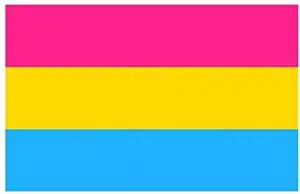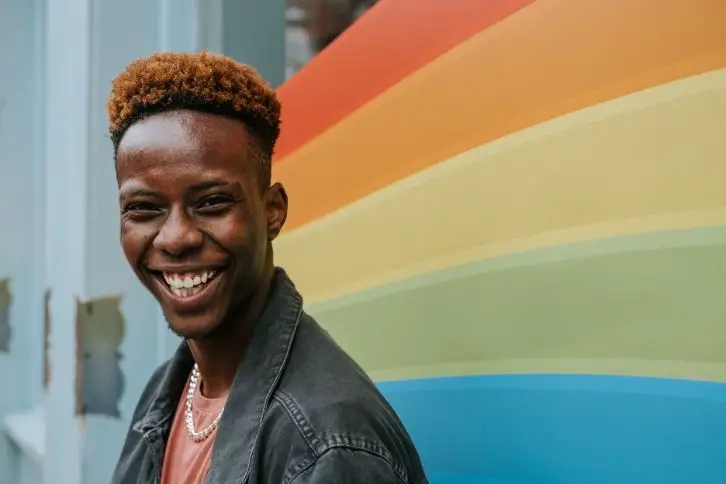If you have assumed that the popular LGBTQ+ flag that is seen everywhere is the only pride flag available to represent members of the community, then you are very wrong indeed. There are other flags used by different groups, genders, and identities to create awareness of their unique needs and experiences — including the gay & lesbian flag, the trans flag, the intersex flag, and many more.
Whether you are a member of the LGBTQ+ community or an ally, it is important that you know which flag belongs to each community. The lesbian flag is different from the pansexual flag, and also different from that of non-binary.
This article will explain the various LGBTQ+ flags and what they represent so you are never confused, lost, or ignorant ever again (at least on this subject).
The Gilbert Baker Pride Flag
The Gilbert Baker flag has hot pink, red, orange, yellow, green, turquoise, blue, and violet colors. The flag was created by Gilbert Baker in 1978 in San Francisco when the gay community was beginning to gain ground and fight for its rights. The colours on the flag were chosen from the colours of the rainbow which symbolizes hope after Noah’s flood.

Updated Philadelphia Pride Flag
The updated Philadelphia flag was developed in 2018 by Daniel Quasar. This new flag was created to include other new members of the community. The flag incorporated black and brown alongside the original six colors on the rainbow flag. Daniel’s version moved the black and brown colours to the side as part of the triangle that already had colours of the trans flag intersecting with the traditional rainbow flag.

Demisexual Pride Flag
Demisexuals are people who need to feel a strong emotional connection with someone to find them sexually attractive. There is no specific date as to when the flag came to be, but it is similar to the asexual flag in its colours. The colours represent asexuality (black), demisexuality (grey), sexuality (white), and community (purple).

Polyamorous Pride flag
The polyamorous pride flag is dated back to Jim Evans in 1995 when he wanted to create an anonymous symbol for the community. Polyamory is a form of sexual orientation that allows for consensual non-monogamy that details emotional connections among multiple partners.
The colours on the flag are blue (which represents openness and honesty of all partners), red (represents love and passion), black (represents support for people who cannot come out as polyamorous), and yellow (represents emotional connection).

Lesbian Pride Flag
The lesbian flag has different colours and meanings; over the years new colours have been introduced to replace the first lesbian pride flag. The flag, created by Emily Gwen, is intended to include the full range of lesbian identities. The colours represent gender non-conformity (dark orange), independence (orange), community (light orange), unique connections to womanhood (white), serenity and peace (pink), love and sex (dusty pink), and femininity (dark rose).

The Trans Pride Flag
The transgender flag was created by Monica Helms, a transgender activist and a former member of the U.S Navy, in 1999. The colours on the flag are light pink and light blue which is commonly used to represent baby boys and girls. The white stripe in the middle represents people who are intersex, transitioning, or identify as neutral or undefined gender.

The Intersex Pride Flag
The intersex pride flag was created in Australia by Morgan Carpenter in 2013 to unify the intersex community. The flag has purple and yellow colors which represent gender-neutrality. The colours avoid referencing gender stereotypes or the use of symbols that relates to gender.

The Bisexual Pride Flag
The bisexual flag was designed by Michael Page in 1998. Prior to this time, every member of the LGBTQ+ community identified with the rainbow flag. It was in the 1990s that a lot of these communities decided to break out and create their own identity. The pink colour on the flag represents same-sex attraction, the blue represents heterosexual attraction, and the two colours fade into each other to form purple.

The Pansexual Pride Flag
Pansexuals are people who do not restrict their attraction to a specific gender or genders. The flag became popular in 2010 but the identity of the creator remains unknown. The pink on the flag represents attraction to those who identify as females, and blue represents attraction to people who identify as male, the yellow represents those who identify as genderqueer, non-binary, agender, androgynous, and others who do not identify as male or female.

The Asexual Pride Flag
The asexual flag was created in July 2010 by the asexual visibility and education network. Although the flag may be the asexual flag, it is not strictly for them alone. The black on the flag stands for asexuality, the gray represents the grey-asexuality and demisexuality, purple for the community, and the white for non-asexual partners.

The Non-Binary Pride Flag
The non-binary flag was designed in 2014 by Kye Rowan. The people within the community do not fall into the male-female gender binary. The colours of the flag represent yellow (people outside the traditional gender binary), white (people with multiple genders), purple (people whose identity incorporates aspects of male and female), and black (people who do not identify with any gender).

Genderqueer Pride Flag
The genderqueer flag was designed by Marilyn Roxie in 2011 and initially represented both non-binary and genderqueer people. The colours on the flag are lavender which represents androgyny, white for agender identities, and green for non-binary people.























About Me
Fashion & Beauty Enthusiast
Hi, I'm Fanti. I'm a fashion, beauty, and lifestyle enthusiast, and the ultimate curves queen. Here, I share beauty, fashion, and lifestyle tips to teach, inspire, and give confidence to all women.